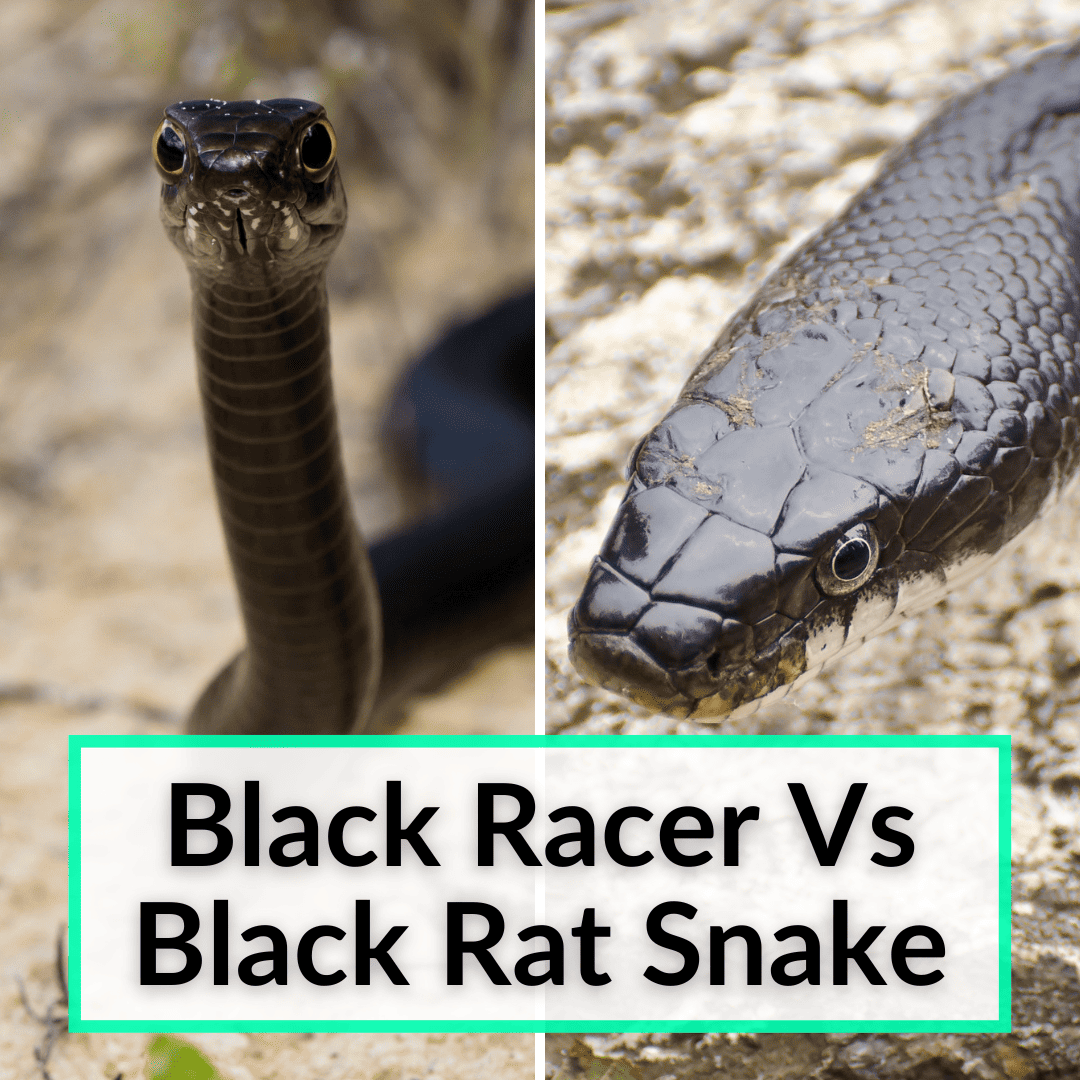
The differences between a black racer vs black rat snake are not as readily apparent.
But they are more important. Especially if you are considering one of these snake species as a pet.
That’s because one makes for a good pet, while the other does not. At all.
Keep reading to learn all about the differences and similarities between black rat snakes and black racers, including which species is well-suited to being a pet and which one is not a good pet.
Table of Contents
- 1 Black Racer Vs Black Rat Snake
- 2 Black Racer Snake Vs Black Rat Snake: Final Thoughts
Black Racer Vs Black Rat Snake
We will begin our comparison of the black rat snake vs the black racer snake by looking at each species individually, before comparing them directly. We will finish by covering the advantages of each as a pet. In this case, only one of the two black snakes makes for a good pet.
The Black Racer Snake
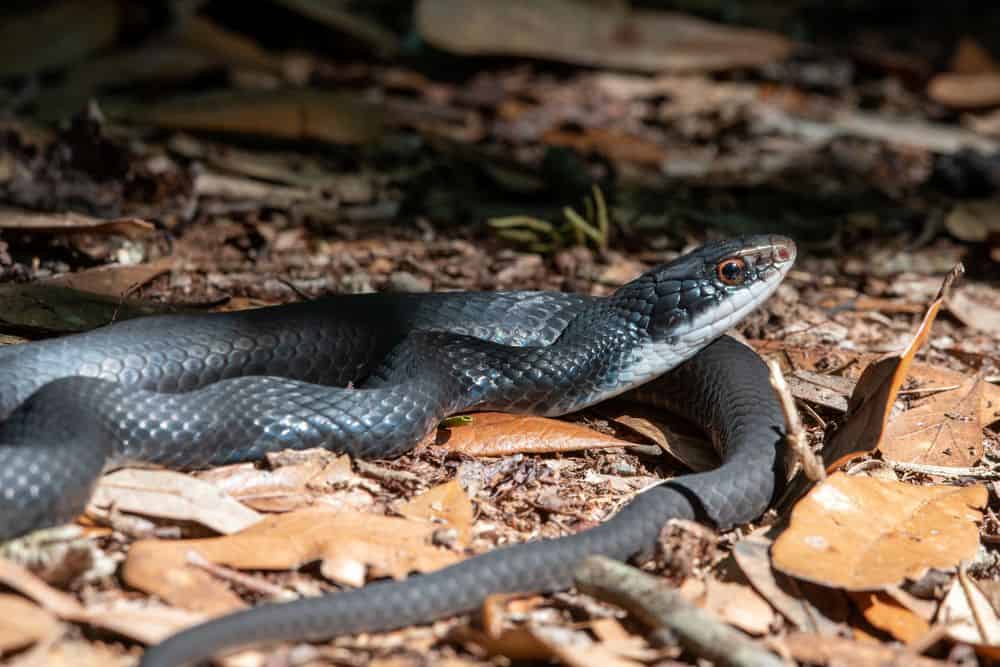
The North American black racer snake is a constrictor that belongs to the genus Coluber. The average black racer measures between 3 and 6 feet (0.9 and 1.8 meters). It is slender and has a whip-like tail. Not all racer snakes are black. You can also find them in brown, olive green, or dark blue coloring.
Habitat And Habits
You can find racer snakes throughout the North American continent, including southern Canada and Central America. They live in the prairies, along the edges of woods, in shrubs, and in deserts. You can also find them along rocky hillsides and the edges of swamps and marshes.
The black racer snake is quick-moving, which is where it gets the name ‘racer’ from. Racers are capable of attaining speeds of 8 miles per hour, which is faster than most snakes.
When threatened or held, they fight back roughly and may strike at their handlers repeatedly. They also shake their tails on the ground, like rattlesnakes, to deter their predators.
Diet
The diet of the black racer snake is mainly rats, lizards, insects, birds, eggs, frogs, and other smaller snakes.
Reproduction
Racer snakes reproduce via the oviparous method of reproduction. They lay eggs that develop and hatch outside their bodies.
The Black Rat Snake
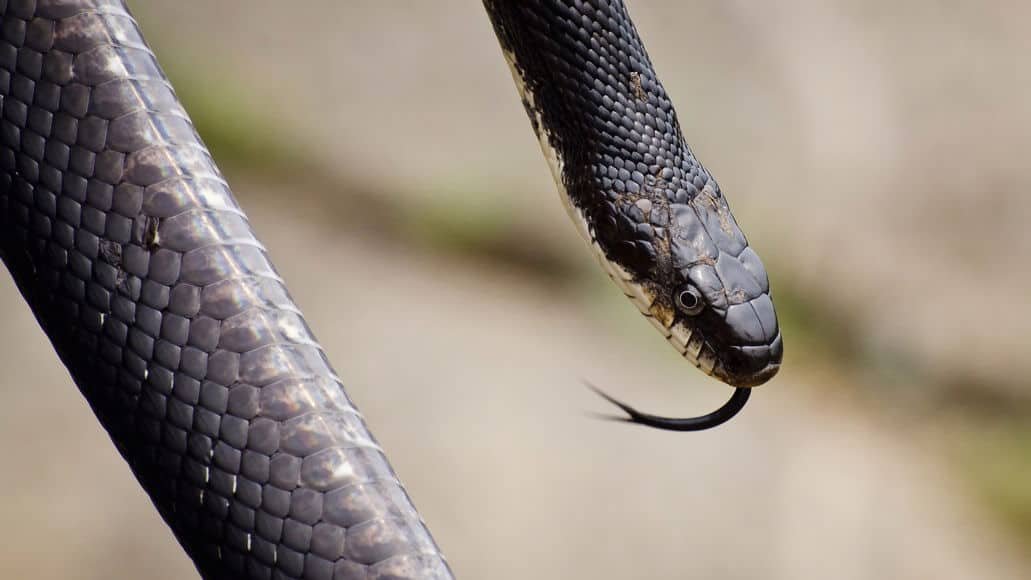
Black rat snakes – also called Eastern rat snakes – are members of the Colubridae family and most belong to the Elaphe genus.
They are large snakes that typically measure between 3 and 5 feet (0.9 and 1.5 meters). They have flat bellies that help them climb well. Eastern rat snakes or black snakes have shiny black bodies with light-colored bellies. They have white throats and chins.
Their heads are wider than their necks and the rest of their bodies. Black rat snakes are also called pilot snakes, because the species is thought to have led timber rattlesnakes and copperhead snakes to their winter dens.
Habitats And Habits
The black rat snake is found in North and South America, Asia, and Europe. It is one of the most common snake species in North America.
You will find them around farms and buildings, where there are plenty of rats and mice to eat. They get their name from their main food. Black rat snakes give off a foul-smelling musk when threatened. They also shake their tails like rattlesnakes to deter their predators.
Diet
Rat snakes mainly eat rats, mice, and rodents. In the absence of these, they may eat lizards, insects, birds, eggs, and other small animals.
Reproduction
Rat snakes reproduce by the oviparous method. Females lay around 30 eggs and the hatchlings measure 7 to 14 inches.
Difference Between Black Racer And Rat Snake
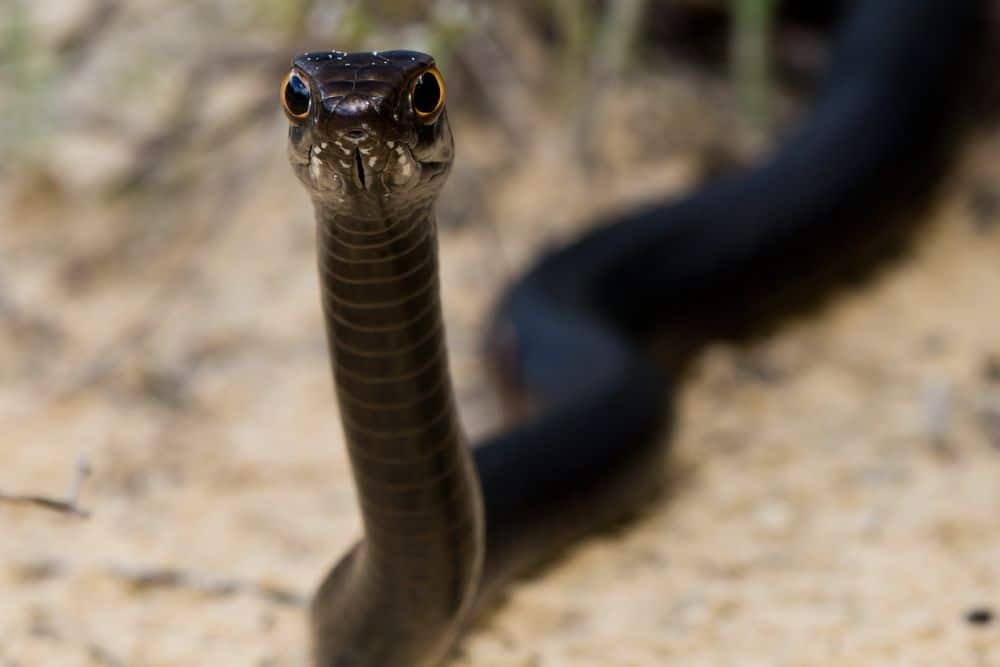
There are a number of key differences between these two snake species. Let’s take a look.
Physical Differences
Black racer snakes have smoother scales and agile, slender bodies. On the other hand, black rat snakes have keeled scales with thicker, more muscular bodies. Due to their slender shapes, racers can move fast. Rat snakes are not as fast as racer snakes.
Different Habitats
As mentioned above, black rat snakes mainly inhabit grain storage silos, chicken coops, sheds, basements, and farmhouses where rats are abundant. Black racer snakes are found in forests, deserts, swamps, and marshes.
Habits When Threatened
Rat snakes are mostly docile and won’t strike or harm their handlers. They prefer to slither away when threatened. Sometimes, they may shake their tails on leaves to sound like rattlesnakes. At times, they release a foul-smelling musk.
Racer snakes are aggressive snakes. They are known to strike repeatedly when threatened. For this reason, they do not make great pets.
Dietary Differences
Although both snakes are nonvenomous, their diets and methods of killing their prey differ greatly. The racer snake eats a wide range of small animals, like lizards, toads, birds, and rodents. It is also an active hunter that chases its prey.
The rat snake’s diet mainly consists of rodents like rats and mice. It uses constriction to kill its prey. Rat snakes are mostly ambush hunters, although sometimes they may actively pursue their prey.
As Pets
Black rat snakes are popular pets among experienced and newbie snake handlers. They are docile and laid-back. They are also known to get more comfortable with being handled as time goes by.
Black racer snakes do not make good pets, because they do not take well to being handled. They are aggressive and do not do well in captivity.
Similarities Between Black Rat and Black Racer Snakes

Next, let’s take a look at the main similarities between these two snake species.
Non Venomous
Both species of snakes are nonvenomous. They use different methods of killing their prey. Occasionally, they may bite humans, but they usually avoid doing so. Rat snake bites can be painful and can result in punctured skin.
Beneficial To The Ecosystem
Both varieties of snakes are beneficial to humans. They help curb rat populations and are useful around farms where these pests tend to damage stored food grains.
Unnecessarily Killed By Humans
Despite being nonvenomous and harmless, both species of snakes get killed by humans. This is because they mimic rattlesnakes by shaking their tails in the fallen leaves. This sounds like a rattler’s rattle.
Humans are quick to conclude that they are dangerous and venomous. In reality, rat snakes and racer snakes are quite good to have around, since they curb rat and other pest populations.
Reproduction
Both snakes use the oviparous method of reproduction. They lay around 12 to 30 eggs and the eggs hatch 45 to 75 days later.
Advantages Of Keeping A Black Racer As A Pet
Please do not keep a black racer snake as a pet. It does not take well to captivity and could even die.
Also, wild-caught racers tend to be high-strung, untrusting, defensive, and aggressive. They tend to strike repeatedly and their bites can be painful. These snakes should only be handled, if at all, by an experienced herpetologist.
Advantages Of Keeping A Black Rat Snake As A Pet
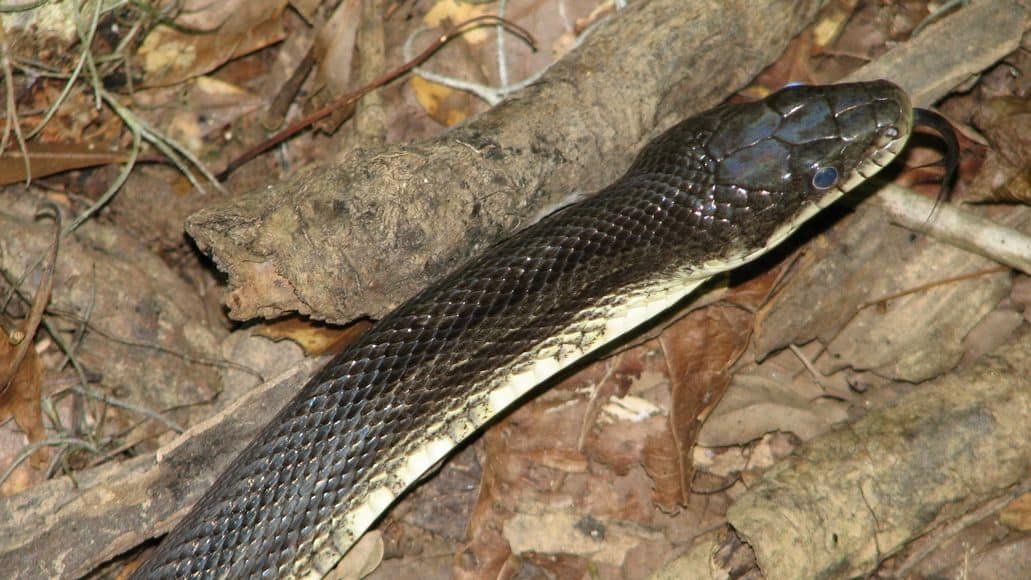
Black rat snakes make good pets, due to their relatively small size (compared to other pet snakes) and their docile temperament. However, it is still better if they are kept by intermediate and experienced snake keepers.
The minimum size of a vivarium for a rat snake is 4 ft by 2 ft by 2 ft. You’d also need a heater to maintain the temperature between 71° and 77° F (22° to 25°C). The vivarium will also need a soft reptile substrate and a UV lamp. Feed your rat snake thawed frozen mice, or reptile frozen foods.
Black Racer Snake Vs Black Rat Snake: Final Thoughts
Both the black racer snake and the black rat snake have unique characteristics and play important roles in their ecosystems. While both species are nonvenomous and beneficial for controlling pest populations, they have distinct differences in their behavior, habitat preferences, and suitability as pets.
The black rat snake is generally docile and can make a suitable pet for experienced handlers and even beginners (though there are better species for beginners), whereas the black racer snake is aggressive and does not adapt well to captivity.
It is important to understand these differences and make informed decisions when considering these snakes as pets. Apart from their suitability as pets, both species deserve appreciation and protection for their contributions to the environment.
carl ward says
I, and several men that I know, for a fact,that black snakes smell like cucumbers. The people that say some snakes smell like melons could be a little off fron cucumbers, and vice versa.